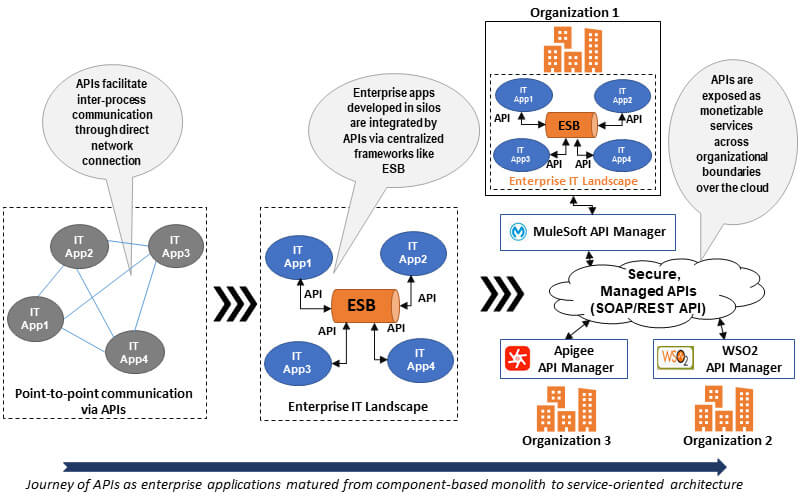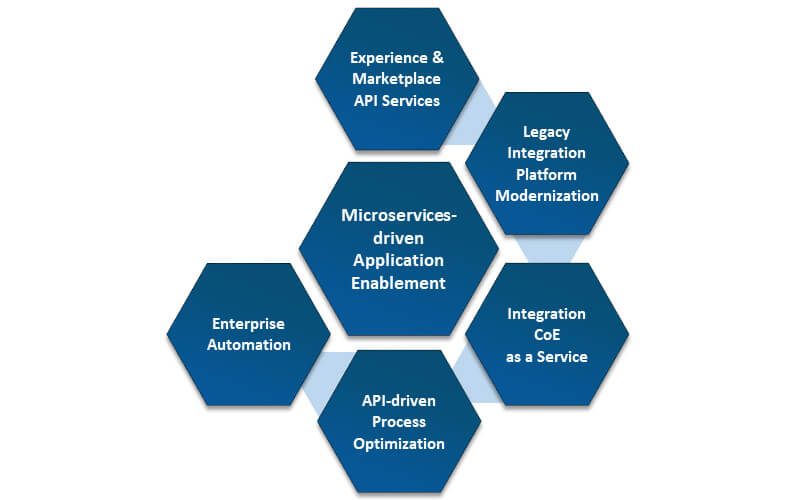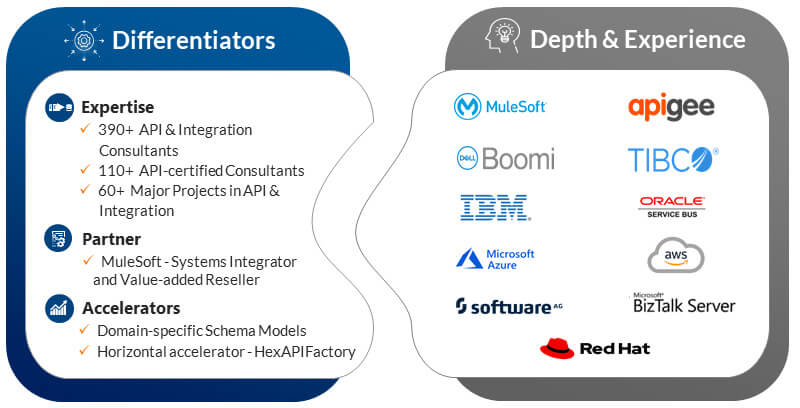How Times have Changed?
Efficiency maximization through enterprise automation and collaboration has always been the holy grail of businesses. In pursuit of this goal to reduce complexity and chaos, inventors developed various tools and systems throughout the history. As a result, we have relentlessly industrialized and automated. And now, we are at the forefront of a machine age where information generated by any person (or device) can be communicated to anyone else almost instantaneously.

Such interconnectedness, combined with software innovation, has opened new ways of conducting business. In this context, let us examine how API (Application Programming Interfaces) strategy has emerged as one of the key differentiators.
The Opportunity that API Economy Opens Up
Despite these advancements, fundamentals of business did not change significantly until recently when value creation was confined to real-world assets, commodities, and services that solve specific problem areas. Data was only a tool to increase efficiency. Now, with exponential improvements in computing power, memory, and bandwidth, it is easily possible to collect, store, and analyze data at unimaginable scales. This has empowered businesses to continuously analyze consumer preferences in real-time and determine their sales/distribution strategy. Therefore, organizations are no longer looking at data as only a means for improving operational excellence. Instead, managing data has become the core that drives business.
Consuming and exposing rich data via managed APIs has become the most potent tool to realize this vision and turn it into an opportunity to generate revenue.
APIs are Not Just the Engineering Tools that Enable Back Office
APIs were originally intended to establish formal contracts to exchange structured information between distinct application components from multiple vendors (for example, between an operating system and application software). With the advent of Service-oriented Architectures (SOA) and data standards (XML, JSON, etc.), APIs emerged as a robust and efficient method to transport data across multiple application landscapes transcending technical and organizational boundaries. IT departments capitalized on this and created highly interoperable business applications that could seamlessly communicate via webservices.
But today, the term API has traversed beyond this limited connotation of being just another mechanism for software and API developers to design systems. It has now become one of the main pillars on which the core line of business operates across industries like banking, insurance, manufacturing, travel, retail, etc. Following are some examples that showcase how businesses are utilizing APIs (usually coupled with an omnichannel strategy) for enhanced customer experience:
- Component suppliers in industries such as electronics etc. expose their pricing and availability information in the form of APIs. These APIs can be directly integrated into the procurement systems of OEMs.
- Banks, through Open Banking Standards, publish their customer information such as spending habits, payments, etc. for the outside world to consume and develop web/mobile apps
- Auto insurance companies use Machine to Machine (M2M) technologies to collect data on the driving habits of their customers. APIs collect such data through the sensors attached to the vehicles.

Figure 1
Exposing APIs as Monetizable Services
Advances in technology and processes enable seamless ways to expose APIs for revenue generation, provided they are backed by suitable API integration services. Just like any other evolutionary phenomenon, leveraging APIs as a commercial revenue generating tool is not a sudden development. It’s a result of step-by-step improvements at each level of system engineering. Following are some of the key enablers that have shaped the ecosystem –
Infrastructure and Firmware
Unless the data from enterprise legacy systems is deployed on infrastructure that enables efficient and frictionless management of resources, it’s bound to be a risky exercise (due to unpredictable capital expenditure) to expose it as APIs to external partners. Thanks to the advancements in virtualization of hardware/firmware (hypervisors, containers), organizations can now transform their legacy data centers into ‘easy-to-maintain’ private clouds where virtual machines can be spawned and governed centrally.
Middleware Technologies and Tools
In addition to the modern virtualized data centers, mature mechanisms for accessing data from disparate systems is critical for API enablement. Developments in the middleware technologies like messaging (e.g. Message Oriented Middleware (MOMs) like Message Queues (MQs), Enterprise Service Bus (ESB) etc.), remoting (e.g. Remote Procedure Call (RPC), Object Request Brokers (ORBs), HTTP invokers etc.), and governance (e.g. reverse proxies, API gateways etc.) have created an environment where relevant data (for API enablement) can be routed through secure and controlled channels.
Architecture Patterns
Figure 1 above shows the journey of enterprise IT architectures from the primitive point to point integration stages to highly inter-operable styles.
As we can see, in the modern paradigm, our goal is not just to access data through systems and tools but also to expose it as APIs to the outside world. Exposure of this data as managed services across organizational boundaries needs loosely coupled, scalable deployment architectures and processes. In order to meet these requirements, IT architectures transformed itself from component-based monolithic assemblies to independently deployable microservices.
In the traditional pattern, the components attain value only within the context of a larger product and are designed to serve a specific purpose (e.g. ERP, CRM systems, etc.). Whereas in a microservices development style, each service is designed to deliver business value independently at a lower level of abstraction (e.g. pricing APIs, specific customer information APIs, etc.). These microservices can further be combined and composed to create Process APIs and applications at higher levels. This paradigm ensures risk isolation, accountability, and predictability while conducting new experiments on value creation.
Development and Operations Processes
In order to develop and maintain such models, development teams should also operate in an agile and frictionless manner. In line with this, SDLC methodologies too evolved to keep pace with the technical changes. For instance, modern development processes such as Scrum, Kanban, etc., with continuous integration and continuous deployment (CI/CD) tools are designed to deliver business value at the micro-level in the shortest possible timeframe without long release and testing cycles.
Fears Around Data Security are Allayed by Technology & Regulations
Technical possibility and utility alone are not the sole determinants for decision-makers to adopt a successful API strategy. It should also be robust and secure. Without adequate mechanisms to prevent unnecessary exposure of data to the outside world, an API strategy would fail to gain seriousness among CXOs.
Today, organizations are armed with techniques at multiple levels to secure flow of data via APIs. These include:
- Protection of data during transit via transport layer cryptographic standards such as TLS. These ensure data transmission happens only via connections established through digital certificates issued by trusted Certificate Authorities (CA).
- Network level entry barriers enforced by ACLs configured on firewalls
- Application-level authentication and access controls enabled by modern API gateways and API management frameworks
- Storage of sensitive data in an encrypted format
- Data access governance policies managed via access management products
- Government regulations such as GDPR that impose penalties for non-compliance
Expertise that Organizations must Seek to API Enable their Business
The Figure 2 below shows some of the services that enterprises can seek to integrate their businesses into the API ecosystem.

Figure 2
Hexaware has honed its expertise in these areas over the years. Some of our differentiators are as under:

Figure 3
Conclusion
In short, API enablement is no longer a good to have feature but is all set to be the core strategy for the digital transformation of businesses. Maturity on technical, process and regulatory aspects make it even more compelling to adopt the same for revenue generation.



















